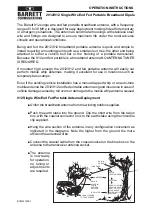
Whipflex VHF Masthead Antenna
1. Select the highest position on the boat, ideally
at the top of the mast, for maximum radio range
and clear of any other apparatus such as revolving
radar aerials, wind speed indicators and rigging.
The bracket is designed for a vertical surface.
2. Use the bracket as a template guide and drill
the 3 holes marked X to a 3.5mm diameter and
the cable entry hole marked Y to a 10mm diameter.
Fig. A
.
3. Fit the bracket to the mast top with the screws
supplied. Place the Antenna onto the bracket
and screw the black nut onto the threaded shaft
of the base; the wider, flat part of the nut to be
against the underside of the bracket. Ensure that
the base is correctly slotted into the bracket. Turn
the nut figertight to the underside of the bracket
and use a 25mm spanner to add a further ¼ turn
to secure it tight.
Fig. B
.
4. Ensure that the plastic grommet is correctly
placed on the cable near the antenna. Unscrew
the PL259 radio plug from the cable end and
remove the grommet near that plug. Thread the
cable through the hole Y in the bracket centre
and feed the cable down the mast. Leave a small
loop of cable between the Antenna and the hole
Y. Press the grommet firmly into the hole so that it
holds the cable in place.
Fig. B
.
5. Thread the cable out at the bottom of the
mast through a pre-drilled 10mm hole and fit the
other grommet supplied. For easy un-stepping
of the mast and withdrawal of the cable from
the radio, fit a V-Tronix ACC 105 Deck Connector,
following the instructions in that pack. (Ensure the
cable end is waterproofed in storage).
6. Feed the cable to the radio using the shortest
possible route, avoiding anything that may
damage the cable. Leave a short length of cable
for access to the radio and cut off any surplus. Re-
connect the PL259 plug as in
Fig. C
.
Note:
To check continuity, there should be a
10k ohm resistance between the cable inner
conductor and the outer sheath.
GB




































